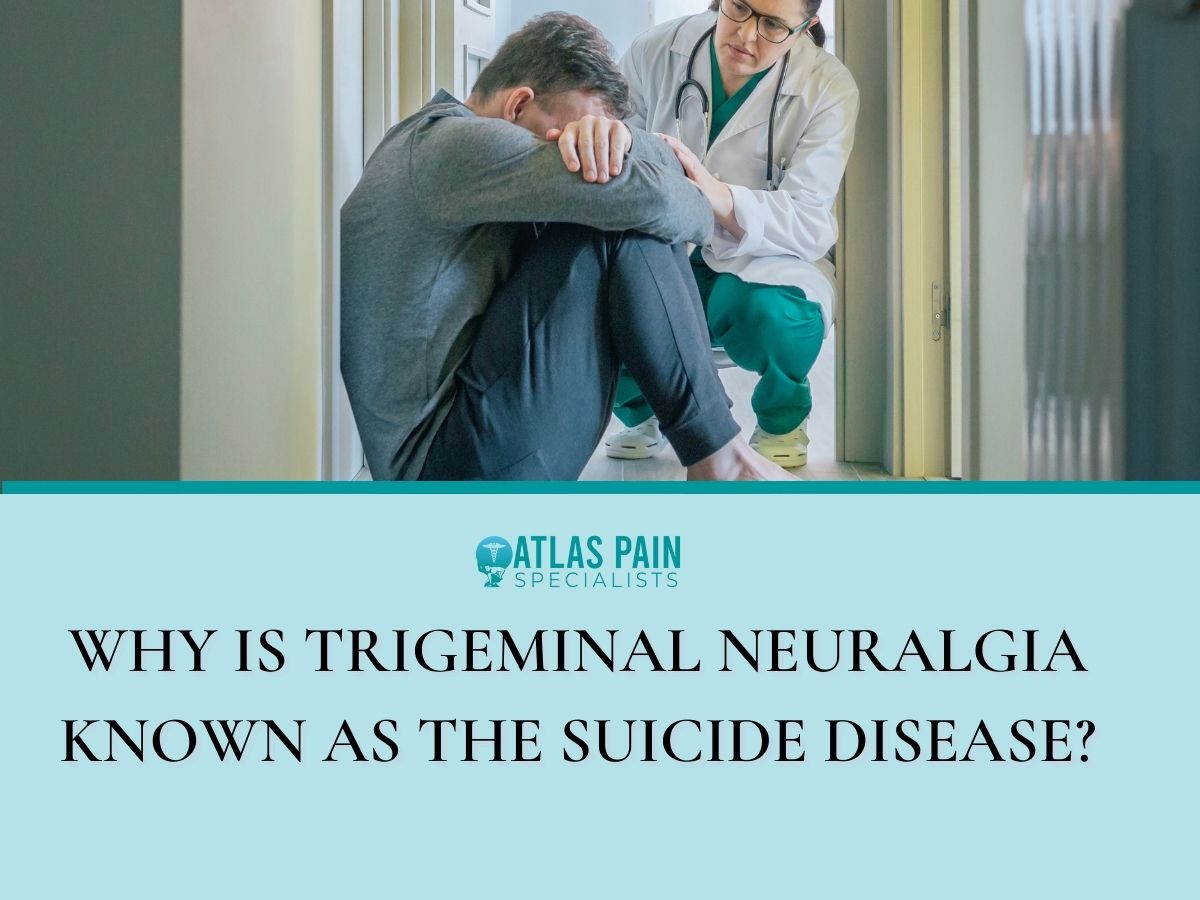

Why is Trigeminal Neuralgia known as The Suicide Disease?
Suicide Disease is a medical condition that affects the trigeminal nerve in the face. There are many names for it, but one stands out above the rest: the suicide disease.
In some circles, the condition is also referred to as Fothergill’s disease, prosopalgia, or tic douloureux. Its medical name is trigeminal neuralgia, and it is unquestionably one of the most painful chronic pain conditions a patient can suffer from, hence the name.
So, what is it about this condition that makes it the worst pain a person could experience while also remaining a mystery to many medical professionals?
Continue reading below to find out more about the suicide disease.
What is The Suicide Disease: Trigeminal Neuralgia
It affects the trigeminal nerve, causing pain in the ear and parts of the face, including the eye, nose, lips, teeth, forehead, cheeks, and side of the face. It has no cure, and although it primarily affects people aged 50 and above, it has also been recorded in patients younger than five years old.
The trigeminal nerve
This nerve begins just behind the ear on either side of the face and laterally spreads across the face. It branches into three:
- Ophthalmic/upper branch: It conveys sensory stimuli in areas above the eyes.
- Maxillary/medial branch: It conveys sensory stimuli in the area between the eyes and the upper jaw.
- Mandibular/lower branch: It conveys sensory stimuli from the lower jaw, including the gums and lips.
These branches spread across the temple, lips, cheeks, and jaw and meet to form the Gasserian ganglion and connect to the brain stem. Trigeminal neuralgia may affect these three branches but mainly the middle and lower branches.
Why is Trigeminal Neuralgia Called The ‘Suicide Disease?’

This condition has been described as one of the most excruciatingly painful experiences a person can have. It may be acute or chronic in nature, and it may cause the patient to consider ending their lives altogether.
The pain, combined with the psychological and social consequences, can send a patient into a dark chapter of their life.
The Main Causes of The Suicide Disease:
While the suicide disease or damage to the trigeminal nerve is a relatively rare condition, there are a few key things that may cause such pressure:
- Blunt force or injury to the face or head
- Pressure from a blood vessel that presses against it
- the nerve
- Multiple sclerosis
- Scleroderma (chronic tightening and tightening of the connective tissues and skin)
- A tumor
Symptoms
With migraine’s being the most common symptom of the suicide disease, trigeminal neuralgia can often be misdiagnosed, as they’re everyday experiences for many.
Some other symptoms can include:
- Short and sharp jolts of pain typically lasting a few seconds or minutes, mostly on one side of the face.
- Sensitivity to light, sound, movement, or wind.
- Nausea and vomiting.
- In chronic cases, the pain goes on without relief.
In some cases, these symptoms may go away before reappearing later in life. As the condition worsens, the time interval between these reliefs becomes shorter, and the condition progresses from acute to chronic in nature.
It is possible to experience periods of pain relief following or between attacks, which are frequently accompanied by a mild ache, throbbing, or burning sensation.
Diagnosing Trigeminal Neuralgia:
Suicide Disease is a condition sharing many symptoms with other medical conditions, such as
| Symptoms: |
| ✅ Migraines |
| ✅ Herpes zoster (shingles, post-herpetic neuralgia, or reactivated chickenpox) |
| ✅ Cluster headaches |
| ✅ TMJD (temporomandibular joint disorder) |
| ✅ Temporal arteritis (inflammation of some of the major arteries in the head and neck, which causes pain in the jaw) |
| ✅ Sinusitis (inflammation of the sinus lining) |
| ✅ Arteriovenous malformation (the veins and arteries become tangled ) |
Because they also cause facial pain, these are the first items on the medical practitioner’s checklist to be evaluated. A physical and neurological examination is performed, considering the patient’s medical history, work environment, and location.
When a patient experiences gum pain, they may choose to visit a dentist rather than seek medical attention. When there is no underlying problem, the dentist may recommend that the patient see a doctor.
Conventional diagnosis

Magnetic resonance imaging (MRI) is a standard test used to rule out other potential causes of pain and to help determine the source of the pain. It is possible to know if a blood vessel or a tumor is exerting pressure against the nerve.
An MRI scan provides detailed images that can reveal nerve damage, but more sophisticated scans may be required to determine the underlying cause of the problem. Someone may have a blood vessel inflicting pressure against a nerve without experiencing trigeminal neuralgia.
Given the large number of sensitive nerves that cross through it, an MRI scan can assist in narrowing down the many possible causes of facial pain.
The Social Effects of The Suicide Disease
Patients who suffer from trigeminal neuralgia can experience difficulties in their personal and social lives.
Pain can be triggered by simple tasks such as brushing one’s teeth, combing one’s hair, eating, or chewing. In addition, a strong gust of wind in the face or a bumpy car ride may set it off.
Individuals suffering from the condition avoid contact with others and activities that may exacerbate their pain. They refrain from eating and conversing, negatively affecting those around them, including their jobs and marriages.
Living with the disease can result in depression, anxiety about having an attack while performing daily activities, weight loss, and social isolation, among other things. Patients can live in fear of their condition returning even after the completion of treatment.
Treatment

Physical and medical therapy treatments are typically considered before surgical intervention.
Medication
Certain medications can reduce the frequency of attacks and the pain associated with them.
These medications were not intended for this purpose, but they do so by slowing down nerve impulses to the brain, thereby reducing pain transmission. This is because trigeminal neuralgia is a rare condition, and there hasn’t been enough time to conduct tests due to the patient’s severe condition.
To treat the disease, anticonvulsant medication or tricyclic antidepressants are prescribed by doctors.
In the treatment of acute trigeminal neuralgia, anticonvulsant medications are very effective. Even though it is an antiepileptic medication, it is a highly effective method of treating the condition and is the standard treatment option.
The most common one is carbamazepine, but other drugs are available if it is not effective in treating the pain. These include
- Oxcarbazepine
- Topiramate
- Gabapentin
- Pregabalin
- Clonazepam
In the event of side effects or ineffectiveness of your prescribed medication, consult with your doctor for advice and treatment options. To avoid allergies or worsening the condition, it is important not to self-diagnose or self-prescribe medicine.
Surgery
Surgical intervention may be considered when prescribed medicine fails when pain is chronic or the other medication option has numerous side effects.
Percutaneous procedures
These procedures usually entail puncturing the skin with a needle while using x-ray guidance or fluoroscopy to guide the needle placement.
- Balloon compression
A tiny balloon, which is passed through a thin tube, is inserted into the area around the nerve to squeeze it, reducing the likelihood that the patient will experience pain. It is carried out at the Gasserian ganglion, where the three branches come together.
- Glycerol injection
Glycerol is injected around the Gasserian ganglion to damage the insulation of the trigeminal nerve fibers.
- Radio-frequency ablation
An electric signal is used to damage the nerve, causing pain.
- Neurectomy
This involves cutting the nerve’s superficial branches so that they do not transmit pain. The nerves may heal over time, resulting in a recurrence of the pain.
- Radio-frequency lesioning
Heat is applied to the Gasserian ganglion through a needle to prevent it from transmitting pain signals. It is also known as radio-frequency ablation as it involves killing the affected nerve.
Stereotactic radiosurgery
This is a non-evasive procedure that doesn’t involve puncturing the skin. It is a relatively new form of treatment that utilizes a concentrated radiation beam to ablate or damage the trigeminal nerve, causing a lesion that blocks pain signal transmission.
The procedure will take one or two hours and be followed by a brief rehabilitation and rest period, after which you will be able to return home. Pins are inserted into the scalp after the area has been numbed to attach a metal frame to your head.
This gives rise to a few side effects of the procedure. They include facial numbness and tingling in the face, which may become troublesome if permanent.
The treatment may take anywhere from a few weeks to a few months, but the pain relief is long-lasting for most patients.
Microvascular decompression
This highly invasive procedure helps treat the condition without damaging the trigeminal nerve. It involves separating the nerve from the blood vessels using an artificial pad (Teflon) or manipulating the adjoining tissue.
The area behind the ear is shaved, and a portion of the skull is removed, later covered with a metallic mesh. This procedure is performed under anesthesia and allows the surgeon to access the affected area.
This procedure provides the most prolonged period of pain relief while also having the lowest likelihood of causing permanent facial numbness.
Post-treatment
After treatment, the patient is advised to avoid triggers of the condition. These may include
- Certain foods, like caffeine, citrus fruits, and hard-to-chew foods. Spicy or cold foods that trigger the nerves may also be avoided.
- Avoid bumpy rides or going to theme parks
- Avoiding direct wind to the face, which can occur on a windy day or from air conditioning,
The Suicide Disease: Side Effects of Medication

Some of the possible side effects of the medication include:
- Drowsiness
- Feeling dizzy and unsteady on your feet
- Concentration difficulty
- Memory problems and feelings of confusion
- Nausea and vomiting
- Double vision
- Allergic skin reactions like hives
Medication such as carbamazepine has been less commonly linked to suicidal thoughts or self-harm, and you should talk to your family or doctor about this when it happens.
Side effects of surgery
Invasive surgery, such as microvascular decompression, has a few side effects.
- Spinal fluid leakage
- Hemorrhage (rare)
- Speech difficulty
- Swallowing and hearing difficulties
- Numbness or weakness in the face
How Do I Live With The Suicide Disease or Trigeminal Neuralgia
Many people have experienced difficulties in their social and personal lives due to this condition. It is a treatable condition, and there are numerous testimonies from people who have lived with the condition available online.
Although neuralgia is a problematic and painful condition to live with, some patients are affected and willing to assist other patients suffering from the same.
Living With the Suicide Disease
According to an article published by the Duke University Department of Neurological Sciences, Frank Skoveira, a patient of the disease for 15 years at the time of his testimony, had gone through a great deal of emotional and physical pain and witnessed the disease’s adverse effects.
Frank Skoveira volunteered as the communications director for a non-profit organization that raises money to fund research into the condition’s treatment and cure. The Facial Pain Research Foundation is the official name of the organization.
He hopes to raise a significant amount of money to fund the research, as seen by the “Drive Away the Pain” sticker on his truck. His mission is to drive around and assist anyone in need by taking them to them.
About Dr. Sean Ormond



